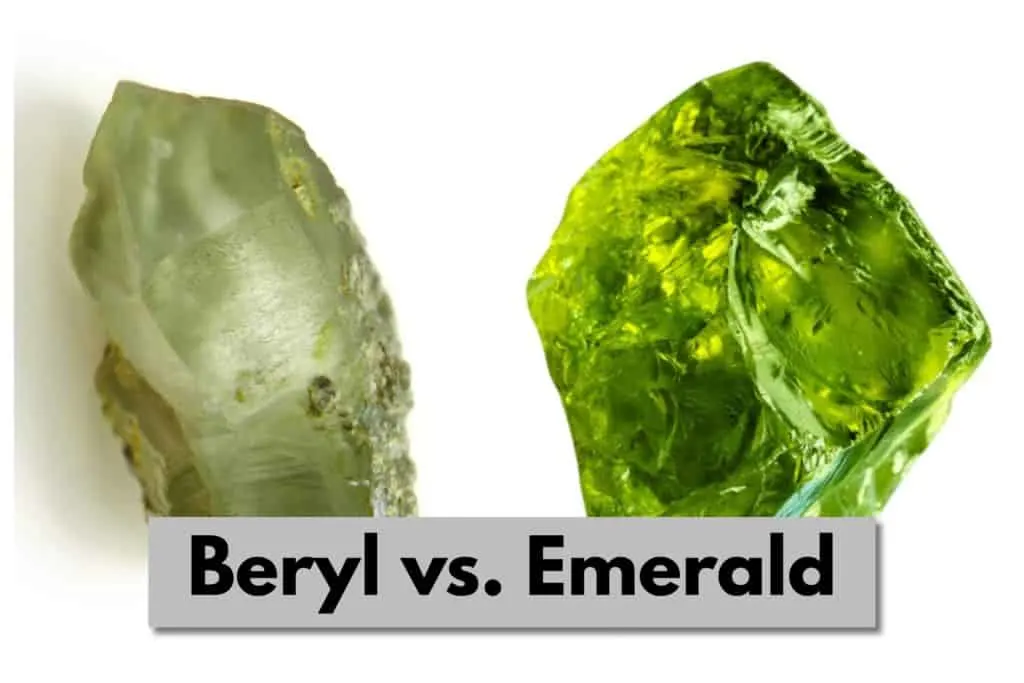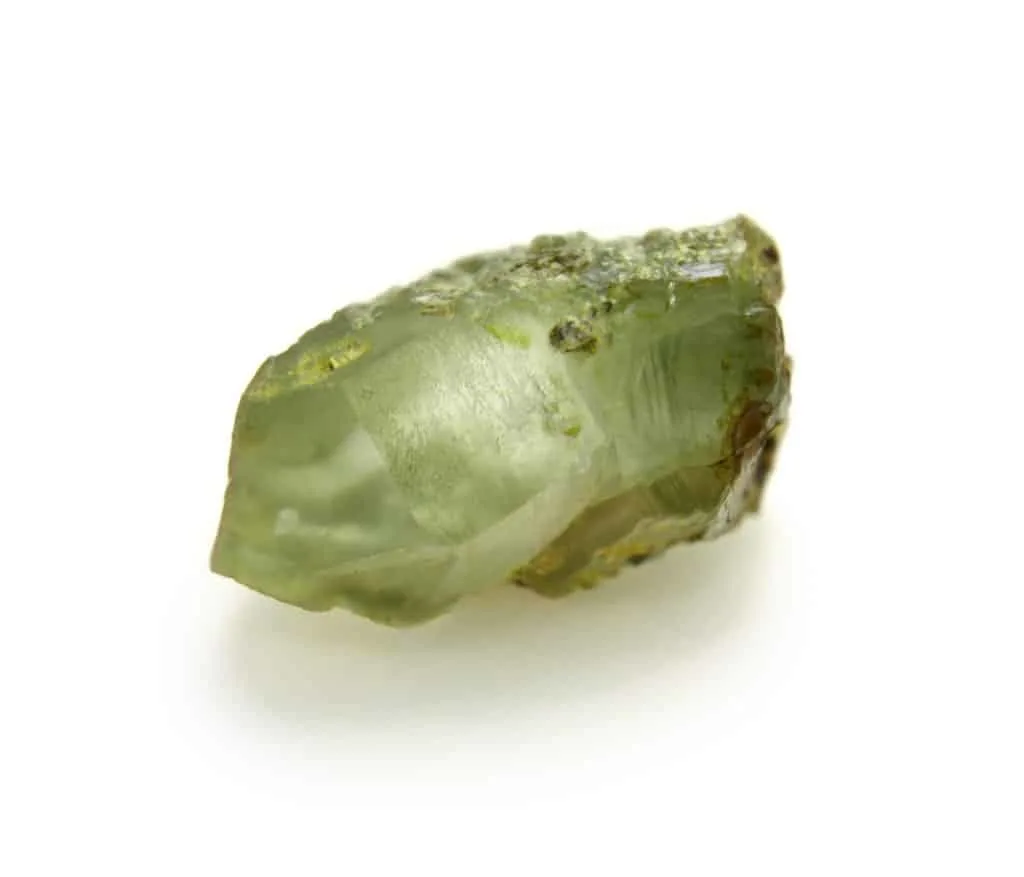As an Amazon Associate, I earn from qualifying purchases with no additional costs for you.
Emerald is one of the most popular gemstones, and it has been known to people for thousands of years. Persons not even interested in gemstones and minerals are familiar with emeralds and know that it usually stands for lush green colour. Fewer people know that mineralogically emerald is a variety of beryl group minerals.
Emerald is a vivid green variety of beryl. The main difference between emerald and green beryl is that emerald colour is influenced by chromium and/or vanadium trace elements. The strong to vivid saturation and medium to medium-dark tone of emerald distinguish it from light-green-coloured green beryl.
Beryl and emerald have the same chemical formula. Both chemically and structurally, they are the same material; however, the price for emerald and green beryl is dramatically different.
What makes Beryl a precious emerald variety and how to draw a distinct border between brothers will be thoroughly discussed. After reading the article, you will surely never mix these two mineral species.

If you want to check out the best books about rocks and minerals identification, you can find them here (Amazon link).
Is Beryl the Same As Emerald?
Beryls and emeralds share a close relationship, yet their subtle nuances are often overlooked, leading to misunderstandings. Beryl, with its distinct chemical formula Be3Al2Si6O18, is the foundation for both minerals.
However, the trace amounts of additional elements like iron, chromium, vanadium, or manganese impart variable colours to the mineral without altering its fundamental structure or chemical composition.
Beryl contains a group of minerals: emerald, aquamarine, red beryl, and others. While every emerald technically falls under the umbrella of beryl, the reverse isn’t necessarily true— not every beryl qualifies as an emerald. The key difference lies in their colour, tone, and saturation, primarily influenced by chromium and/or vanadium in emeralds. These subtle differences give rise to the interesting green dye that distinguishes emeralds from other beryl varieties.
The most trustworthy gemological laboratory in the world makes the next statement regarding emerald and green beryl boundary:
“To most gemologists, gemological laboratories, and coloured stone dealers, it is more correct to call a stone green beryl when its colour is too light to be classified as emerald. Even among that group, however, there’s a difference of opinion about what’s considered “too light.”
The next characteristic exists to find more precise evaluation factors than the individual perception of colour. Generally, the higher the chromium or vanadium content, the more intense the green colour.
At the same time, iron affects the amount of blue. When iron content is relatively high, the emerald has a bluish hue in its main green colour. To sum up, the green colour is purer when the iron content is relatively low.
How to Identify Beryl

Beryl is quite an important mineral and popular gemstone with the formula Be3Al2Si6O18.
The mixing of several other chemical elements results in the formation of several different types of beryl. These include aquamarine, maxixe, heliodor, goshenite, morganite, golden beryl, red beryl, and emerald, which is the most expensive of all the beryl kinds.
There are three colours that can be used to identify beryl: light green, yellowish-green, and greenish-blue. When compared to emerald, the tone and saturation of beryl will be perceived as relatively lighter. In most cases, beryl is less fractionated and less incorporated than other minerals. Neither chromium nor vanadium will be present in the composition of beryl in any trace amount.
The vast majority of gem-quality beryl is found in pegmatites, characterized by crystals of significant size and clarity. There are many instances in which it is possible to cut huge stones that are virtually entirely devoid of inclusions.
How to Identify Emerald

Emerald is truly a legendary stone. It was known to humans from Ancient Egyptian times. It is believed to be Cleopatra’s favourite gemstone when there were no mineral formulas or trace elements.
Now, gemology knows the beryl mineral group and can differentiate the two closest brothers by less than 1% amount of trace elements.
Emerald can be identified by bluish-green to green, with strong to vivid saturation and medium to medium-dark tone. The presence of chromium and vanadium trace elements explains the colour. Emerald is usually highly included and fractured. Emerald will show red colours under the Chelsea filter because of Cr.
Until 1963, chromium was considered the only valid cause of emerald’s green colour. However, the situation changed when a perfect emerald-coloured green beryl from Brazil was discovered.
This beryl was not coloured by chromium, as it was accepted previously, but by vanadium. This year, the GIA Laboratory confirmed that Brazilian green beryl was emerald.
Natural emeralds from when beryllium, aluminum, silicon, oxygen, and one or more of the trace elements that cause its characteristic green color (chromium, vanadium) come together in the correct geological environment.
Unlike beryls, which are mined from pegmatites, most emeralds are mined in regions with metamorphic-rock environments, where pegmatites intersect with ultrabasic rocks or schists (source of chromium).
An active metamorphic environment where emeralds are formed results in numerous inclusions or fractions in emeralds.
They are so common that finding a stone without flaws is almost impossible. That is why it’s a common practice to infill emeralds with oils or resins to increase their virtual clarity.
BTW: Do you want to know more about rock and mineral identification? The books listed below are the best ones you can find on the internet (Amazon links):
- Smithsonian Handbooks: Rocks & Minerals
- Gemstone & Crystal Properties (Quick Study Home)
- Ultimate Explorer Field Guide: Rocks and Minerals (National Geographic Kids)
What Is the Difference Between Beryl and Emerald?
Beryl and emerald are closely related minerals. Mineralogically, every emerald is beryl; however, not every beryl is emerald.
The main difference between beryl and emerald, a vivid green variety of beryl, is their colour tone and saturation, explained by chromium and vanadium in emerald. Emerald is formed in a slightly different geological environment and is usually more fractured and included than beryl.
Here is a table with characteristic features for green beryl and emerald, which help you easily differentiate the two gemstones.
| Characteristic | Green Beryl | Emerald |
|---|---|---|
| Color, tone, saturation | The chemical element that creates the color | The chemical element which creates the colour |
| Strongly bluish-green, bluish-green, very slightly bluish-green, green, slightly yellowish-green, yellowish-green, or strongly yellowish-green colour; mild saturation, light tone. | Iron (Fe3+ and Fe2+) | Chromium (Cr3+) or/and vanadium (V3+). |
| A geological environment of gemstone formation | Granitic pegmatites. | Strongly bluish-green, bluish-green, very slightly bluish-green, green, slightly yellowish-green, yellowish-green, or strongly yellowish-green color; mild saturation, light tone. |
| Sources of gemstone | Brazil, Zimbabwe, and Australia. | Columbia, Brazil, Zambia. |
| Inclusions | Gem-quality species are free from any inclusions or fractures. | Highly included and fractured. |
| Refractive index | 1.577 to 1.583 | Slightly higher (1.565-1.599). |
| Chelsea filter test | Inert to filter. Staying green. | Emeralds containing chromium will turn red under the Chelsea filter. |
TIP: South Carolina is a great state for finding beryl minerals! Check out the best rockhounding location in South Carolina in the article below:
Rockhounding in South Carolina: Where to Go & What to Find
Green Beryl vs Emerald
When beryl is green but not intense enough in colour to be called emerald, it is simply called green beryl. The shades of green beryl can range from light green to yellowish or bluish-green due to iron impurities.
Green beryl and emerald may seem the same, but green beryl will have yellowish or bluish hues along with the main green colour and are typically lighter in saturation. The presence of iron explains green beryl color, however, emerald’s famous green color is caused by chromium and vanadium.
Red Beryl vs Emerald
Red beryl was discovered in 1897 by Maynard Bixby. Sometime after, it was called Bixbite in honour of the scientist. This name is now discredited, as it is similar to bixbyte (an opaque black mineral discovered by the same scientist).
Red beryl and emerald belong to one mineral group, which is beryl. Trace concentrations of manganese produce red colour in red beryl, while chromium and vanadium produce vibrant green in emerald. Also, sometimes red beryl can be called red emerald; however, this name is considered misleading and outdated.
Red beryl is the rarest beryl. It also belongs to one of the rarest gemstones because it’s found in only one place — the Wah Wah Mountains in the US state of Utah.
Red beryl is often a highly saturated, pure red colour called raspberry red. The colour depends on the concentration and valence state of manganese Mn3+ and other trace elements within the gem’s crystal structure.
TIP: Mountains are great locations for finding beryls and other rocks and minerals. Find out what the most common rocks and minerals you can find in the mountains are in the article below:
14 Most Common Rocks and Minerals You Can Find in Mountains
Conclusion
Emerald and beryl are not synonyms. Emerald is vivid green, highly saturated, chromium and/or vanadium bearing a variety of beryl. Every emerald is beryl; not every beryl is emerald.
The most important characteristics which can help to distinguish these two gemstones are:
- colour, tone, and saturation (emerald is bluish-green to green, with strong to vivid saturation and medium to medium-dark tone, green beryl is bluish-green, yellowish-green, light-saturated, and pale tone);
- presence of chromium and/or vanadium (Cr3+ and/or V3+ trace elements fro emerald, Fe3+, Fe2+ for green beryl);
- a geological environment of gemstone formation (metamorphic environment on the contact of pegmatite and shist for emerald, granitic pegmatites for green beryl);
- Source country (emerald originates from Colombia, Brazil, and Zambia; green beryl comes from Brazil, Zimbabwe, and Australia);
- Refractive index (emeralds sometimes have a slightly higher RI of 1.565-1.599 than green beryl 1.577 to 1.583);
- Inclusions (because of the formation environment, emeralds are heavingly fractured and included, while green beryl is far less fractured);
- Chelsea filter test (emerald appears red under a Chelsea filter, while green beryl remains green).
TIP: Hardness testing is one of the basic ways to identify rocks or minerals. Many useful tools are available on the market, but not all are worth the money. Check out the best Mohs scale test kits in the article below:
3 Best Mohs Scale Test Kits: Test the Hardness of Your Gemstones
